A visa is necessary to enter Cambodia and may be obtained upon arrival. There are 2 categories of visa: – tourist visa valid 30 days (20US$) extendable one time for 30 days (45US$). – business visa valid 30 days (25US$) extendable up to 1 year (cost depending on the extension period). Documents required: 1 form, 2 photos, valid passport during 6 months at the date of arrival in Cambodia, appropriate sum. If you enter Cambodia via the border town of Poipet from Thailand, the cost of one <tourist> visa is 1000 Baths and one <business> visa is 1200 Baths, higher costs than here-above mentioned, due to the exchange rate US$/thai Bath (1US$ changes around 30Baths at the end of November 2010). The local Authorities do not accept US$ for payment and that allows some officials to fully take advantage of the exchange rate.
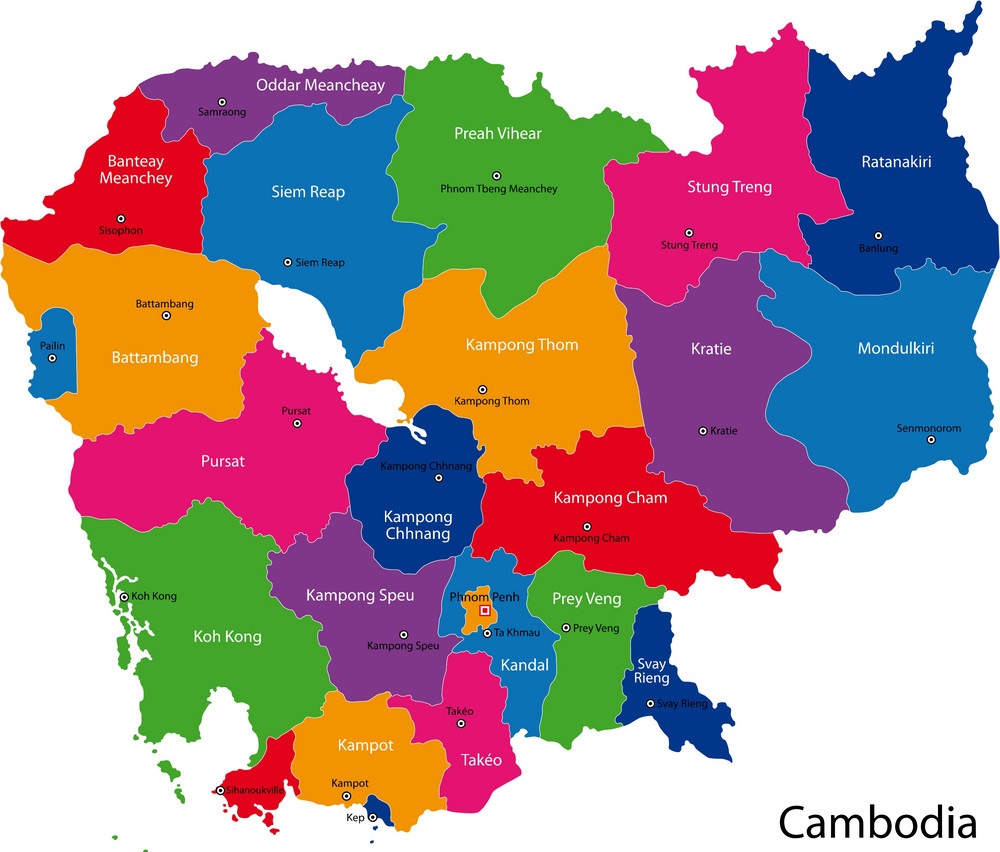
If your visa has expired, it will cost 5 USD per day of overstay then 6USD per day, retroactivly to the first day of overstay, if you have not regularized your situation within a period of 30 days. An other way to get a visa is by internet; just follow the link hereafter and get it online http://www.mfaic.gov.kh. That will avoid you queue up at your entry point of Cambodia. No vaccination is required in Cambodia. Nevertheless, it is highly recommended to safeguard against tetanos, hepatitis A & B, thyphoid. If you travel to certain remote regions, the vaccines against rage, japanese encephalitis and flu are advised. Tropical climate in Cambodia, very hot in summer (mid-March to end of May). In your bag, think of placing an anti-mosquitoes lotion, sunglasses, a hat … before traveling. Customs : you will have to fill in a declaration form at your entry into Cambodia. Avoid heavy luggage. The weight allowed for checked luggage on domestic and international flights is 20kgs per person. International Airport tax : 25 usd / person at Phnom Penh and Siem Reap, now included in the air ticket price as of April 1st, 2011. Domestic Airport tax: 06 USD / person at Phnom Penh and Siem Reap, now included in your air ticket bought in Cambodia. The normal check-in times at airports are 2h for international departures and 1h for domestic departures. But, due to tougher security measures, it is advisable to come sufficiently in advance to avoid queuing. Credit cards: you may obtain cash advance with your credit card at the local banks, the standard charge begins at 2%. Most stores, hotels, and travel agencies accept payment by CB but will add a 4 – 5% commission to the final bill. There are now automatic teller machines in the main towns of Cambodia. Traveler’s cheques: banks and large hotels will accept payment by traveler’s cheques and charge a 1 – 2% commission. Cash: it is important to bring small denominations of US$ for your current expenses, they are accepted and preferred everywhere. The local money-changers, usually located around the markets, have better rates than banks. Internet and telephone: it is the cheapest way to communicate with your loved ones, there are numerous internet shops and cafes throughout Cambodia. Photographies, films, and processing: it is not necessary to bring a lot of films to Cambodia as they can be found everywhere and are very cheap. CAVAR TRAVEL & TOUR will do their best and make efforts to book hotels requested by clients; sometimes, hotel bookings cannot be guaranteed and alternative hotels will be used and booked.
Cambodia Sightseeing
Angkor Thome Capital City
Angkor Thom is a very popular tourist spot. It was established in the late twelfth century to early thirteenth century by King Jayavarman VII. This site is situated 1.7 Km north of Angkor Wat, within which are located several monuments from earlier eras as well as those established by Jayavarman and his successors.

Phnom Bakheng
Phnom Bakheng was constructed more than two centuries before the Angkor Wat. It is a Hindu temple originally built in the form of a temple mountain dedicated to Shiva. Historians believe that Phnom Bakheng was in its heyday, the principal temple of the Angkor region. It was the architectural centerpiece of a new capital that Yasovarman built when he moved the court from the capital Hariharalaya in the Roluos area located to the southeast.

Preah Khan Temple
Preah Khan was built on the site of Jayavarman VII’s victory over the invading Chams in 1191. In its heyday, this was the centre of a substantial organisation with almost 100,000 officials and servants. This temple is flat in design, with a basic plan of successive rectangular galleries around a Buddhist sanctuary complicated by Hindu satellite temples and numerous later additions. With numerous trees and other vegetation growing among the ruins, Preah Khan has been left largely unrestored.
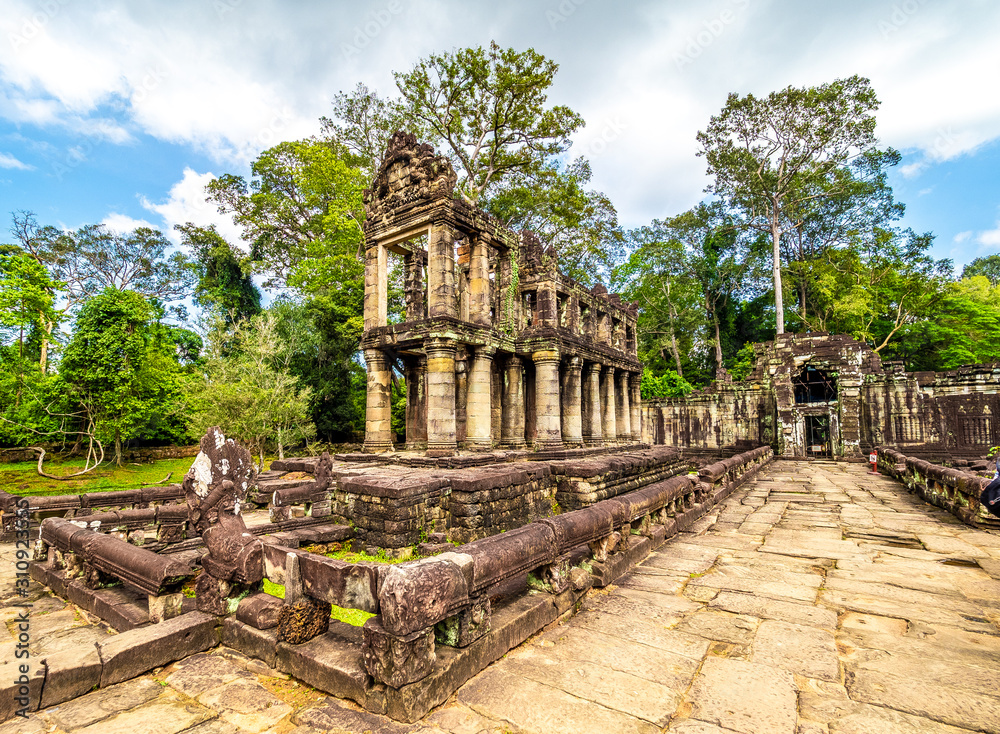
Angkor Wat Temple
Angkor Wat, which literally means ‘City Temple’, is a Hindu temple complex built to replicate the heavens on earth. Constructed for King Suryavarman II in the early twelfth century, it is the best-preserved temple and is the only one to have remained a significant religious centre since its foundation. The temple is the epitome of the high classical style of Khmer architecture.

Banteay Srei Temple
Consecrated in 967 A.D., Banteay Srei was speculated to have been known earlier as Banteay Serai, which means the Citadel of Victory. This was the only major temple at Angkor not built by a monarch; its construction is credited to a courtier named Yajnavaraha, who was a scholar and philanthropist and a counselor to King Rajendravarman. He was known to have helped those who suffered from illness, injustice, or poverty.

Bayon Temple
Bayon is a richly decorated Khmer temple built in the late twelfth century or early thirteenth century. Built at the centre of King Jayavarman’s capital, Angkor Thom was the last state temple to be built at Angkor, and the only Angkorian state temple to be built primarily as a Mahayana Buddhist shrine dedicated to the Buddha. Following Jayavarman’s death, it was modified and augmented by later Hindu and Theravada Buddhist kings in accordance to their religious preferences.

Banteay Kdei Temple
Built in the late twelfth to early thirteenth century during the reign of Jayavarman VII, Banteay Kdei is known only as a Buddhist temple constructed in the Bayon style. It has been occupied by monks at various intervals over the centuries, but the inscription stone has never been discovered so it is mystery; unknown to whom the temple is dedicated.
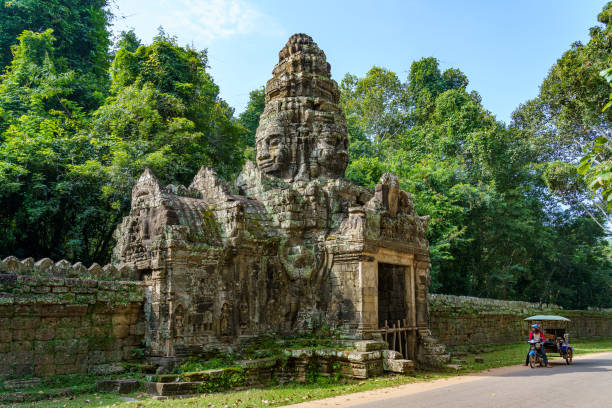
Ta Phrom Temple
Ta Prohm, a Bayon style temple, is believed to be built in the late twelfth and early thirteenth centuries. It was founded by King Jayavarman VII as a Mahayana Buddhist monastery and university. Unlike most Angkorian temples, Ta Prohm has been left in much the same condition in which it was found where the photogenic and atmospheric combination of trees growing out of the ruins and the jungle surroundings have made it one of Angkor’s most popular temples with visitors.
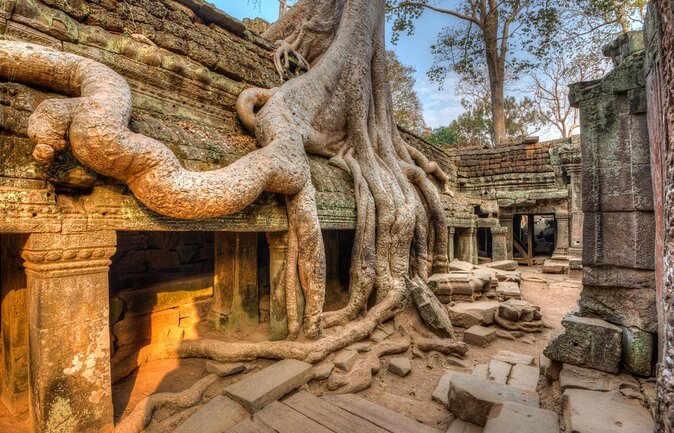
Kravan Temple
Built by King Harshavarman I in the early 10th century and dedicated to Hindusim. Location: East of Angkor Wat and south of Banteay kdei Access: Enter and depart from the east Date: The first half of the tenth century (921) King: Completed during the reign of Harshavarman I (it may have been built by high court officials) Art Style: Transitional from Bakheng to Kho Ker.

Elephant Terrace
The Terrace of the Elephants is part of the walled city of Angkor Thom. The terrace was used by king Jayavarman VII as a platform from which to view his victorious returning army. It was attached to the palace of Phimeanakas. Most of the original structure was made of organic material and has long since disappeared and most of what remains are the foundation platforms of the complex. The terrace is named for the carvings of elephants on its eastern side.
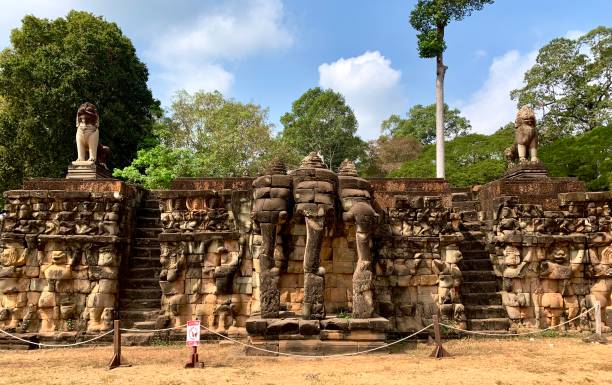
Terrace of Leper King
A double terrace wall at the north end of the Terrace of Elephants with deeply carved nagas, demons and other mythological beings. The inner wall is an earlier version of the outer wall that was covered at the time the outer wall was added. The inner wall was excavated by French archaeologists in the late 1990s.
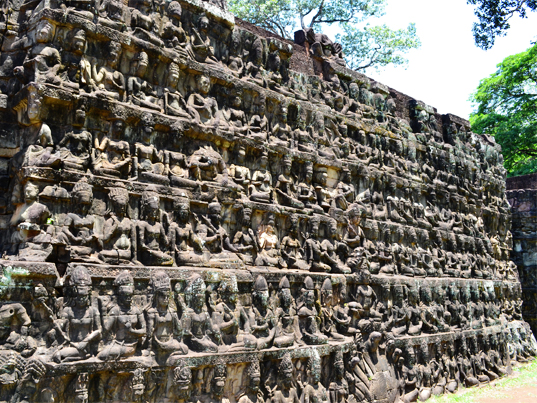
East Mebon Temple
East Mebon is a large temple-mountain-like ruin, rising three levels and crowned by five towers. Jayavarman IV, a usurper to the throne, moved the capital from Angkor to Koh Ker in 928AD. Sixteen years later Rajendravarman II returned the capital to Angkor and shortly thereafter constructed East Mebon on an island in the middle of the now dry Eastern Baray.

Beng Mealea Temple
The remains of Boeng Mealea, which are still partly buried under vegetation, consist of perfectly squared-off sandstone building blocks. The outstanding decoration dates from the fist half of the 12th century.

Banteay Samre
Large, comparatively flat temple displaying distinctively Angkor Wat-style architecture and artistry. The temple underwent extensive restoration this century by archaeologists using the anastylosis method. Banteay Samre was constructed around the same time as Angkor Wat.

Pre Rub Temple
Architecturally and artistically superior temple-mountain. Beautifully carved false doors on upper level, as well as an excellent view of the surrounding countryside. Richly detailed, Well-preserved carvings.
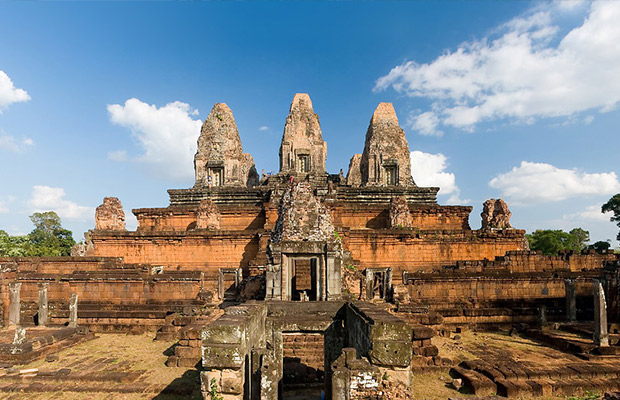
Chau Say Tevoda & Thommanon Temple
Chau Say Tevoda is a small temple of similar design and floor plan to that of Thommanon located across the street (except for additional gopuras and library), but for years appeared as Thommanon´s neglected sister, languishing in significantly worse condition than Thommanon, which had been restored back in the 1960s. Small, attractive temple in very good condition, built at the same time as Angkor Wat. The Angkor Wat style is most easily seen in the style of the towers and carved devatas. Thommanon seems to stand in conjunction with Chau Say Tevoda across the street, but was built decades earlier.

Kbal Spean
It is located at the foot of the mountain. Along the river of Siem Reap, there are a lot of figures of Yoni and Linga spreading out at its bottom.

Takeo Temple
Towering but plainly decorated temple-mountain dedicated to Shiva. Known in its time as ‘the mountain with golden peaks.’ The first to be constructed wholly of sandstone, this temple employing huge sandstone blocks.

Neak Pean Temple
A small island temple located in the middle of the last baray (the Preah Khan Baray or Jayatataka) to be constructed by a Khmer king in the Angkor area. The central temple sits at the axis of a cross or lotus pattern of eight pools. Originally known as Rajasri, Neak Pean took its modern appellation, which means ‘coiled serpents,’ from the uncoiled nagas that encircled the temple.

Preah Ko Temple
Roluos Group: Six towers displaying set on a platform, all beautifully preserved carvings. Originally surrounded by walls and gopuras of which only vestiges remain. Preah Ko was one of the first major temples of the empire at the early Khmer capital of Hariharalaya.

Bakong Group of Temple
Angkorian capital. Hariharalaya. Bakong stands 15 meters tall and is 650x850m at the outer wall.

Phimeanakas Temple (Former Royal Palace)
Impressive laterite and sandstone pyramid. The lack of surviving carving leaves it artistically uninteresting. But it is the tallest scalable temple in Angkor Thom, providing a nice view from the top. The western staircase (at the back) is the most easily ascended.

Koh Ker Temple
The temple complex at Koh Ker, northeast of Siem Reap, represents the remnants of the capital of the Khmer Empire from 928 AD. – 944 A.D. – a very unique period in the Age of Angkor. From the time the Khmer capital was first moved to the Angkor area in the late 9 th century, it would remain there for almost 500 years, with one brief interruption. Just a few decades after the establishment at Angkor there was a disruption in the royal succession for reasons that remain a matter of academic debate. What is known is that in 928 A.D. King Jayavarman IV, possibly a usurper to the throne, created a new capital 100km away at Koh Ker, either moving the capital city from Angkor or creating a rival capital. Obviously a king of much wealth and power, he raised an impressive royal city at Koh Ker of Brahmanic monuments, temples and prasats, surrounding a huge baray (reservoir) Rahal.

River of One-Thousand Lingas
It is located at the foot of the mountain. Along the river of Siem Reap, there are a lot of figures of Yoni and Linga spreading out at its bottom.

Phnom Krom - Tonle Sap Lake
Tonle Sap, the largest freshwater lake in Southeast Asia, is itself a natural wonder.This great lake exists as an ecological anomaly. In early June, at the start of the rainy season, the water level of the Mekong River rises to divert part of its flow off its course to the South China Sea and redirect it into the Tonle Sap. This forces the current to reverse direction, beginning a process that by the end of October will see the Great Lake increasing its size almost tenfold, making it the largest freshwater body in Southeast Asia.

Kulen Mountain National Park
The Kulen Mountain or Phnom Kulen is declared as a National Park. It is an isolated mountain massif located in Svay Leu District and some 48km from Siem Reap. Its highest point is 487 meters. This is widely regarded as the birthplace of the ancient Khmer Empire. During the constructional period of the ancient temples in the nineth century, sand stones were brought from this sacred mountain to Angkor. It was here at Phnom Kulen that King Jayavarman II proclaimed independence from Java in 802 A.D.

Baray
A ´baray´ is a water reservoir – an area of land where dikes have been raised to catch and hold water. Beginning in the 9th century, the construction of massive baray and other such grand projects became one of the marks of Angkorian kingship.

Sras Srong "The Royal Bath"
It was perhaps a chapel to Kama, God of Love. The spot would suit the temper of the strange power, terribly strong and yet terribly tender, and of that passion which carries away kingdoms, empires and whole worlds. Love could occupy this quiet nest embedded in water, which gave the impression that love had come one day and had left there, when he went away, a part of his spirit.

Cambodian Cultural Village
The Cambodian Cultural Village is designed to provide tourists with an excellent insight into the life and culture of the Cambodians; their traditions and practices, etc. In all, eleven villages or sectors, each a showcase of different landmarks and providing a peek into the lifestyles of the people from various provinces including the ethnic minorities.

Angkor National Museum
The Angkor National Museum is classified as one of Cambodia’s premier museum sites. On display are thousands of important Buddhist and Hindu sculptures from the various Angkor temples. Many original pieces recovered for safe-keeping by the authorities from the temple ruins are also on exhibit at this museum.

Siem Reap Pub-Street
In Siem Reap, after returning from the temple tours in the evening, many tourists are taken to Pub Street to take advantage of the happy hour deals or a good meal. The street is so named because it is lined end to end on both sides by pubs, restaurants, and shops

Siem Reap Night Market
Like the one in Phnom Penh, the Angkor Night Market is also designed to give visitors a secure and enjoyable shopping and dining experience in a vibrant, contemporary Khmer environment. Both these night markets offer a wide variety of stalls offering a diverse range of goods and services. A ‘must visit’ when in the vicinity.

Around Siem Reap Town
The reason most people come to Siem Reap is to visit the Angkor Archaeological Park. The town is worth strolling about for itself and there are a number of means to go about enjoying the city. Going about on foot is perhaps the most leisurely and most rewarding. Here, the pace may be quite laid-back to some, but all in all it’s a pleasant place to be at. Along the streets, there are many shops offering services and goods ranging from the basic necessities to fine silk; chic galleries with beautiful display of local art pieces and lots of souvenirs. For food, there are whole streets catering for the travellers tastes, with tasty Khmer fares such as Amok and ‘Khmer curry’, or pizzas, hamburgers and other international cuisines. Explore the backstreets for more shops and restaurants and have fun. In the evening, stroll down Pub Street and mingle with the crowd. There is never a lack of colours while in Siem Reap.


